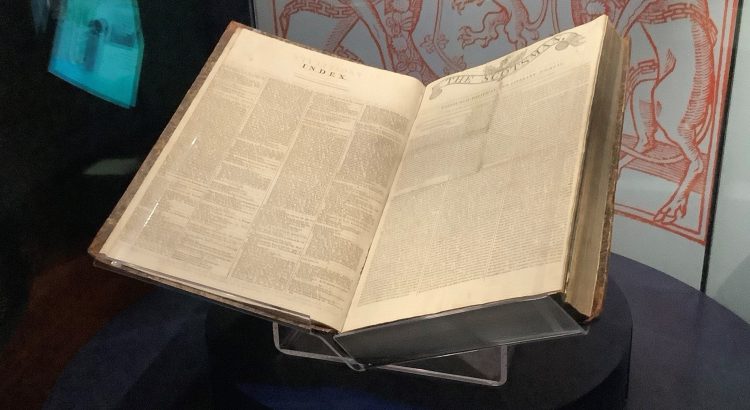The permanent and free ‘Treasures of the National Library’ exhibition at our main building in Edinburgh gives visitors the chance to see some of the most important items in our collections. We have recently refreshed the contents of the exhibition. From March 2023 you can see the first edition of Robert Burns’s ‘Poems’, printed at Kilmarnock in July 1786, the working manuscript of the celebrated novel ‘Rob Roy’ (1817) written in the hand of its author Sir Walter Scott and a selection of programmes and flyers for the Edinburgh Festival Fringe that charts its evolution from 1947 to the present day. You can read more about these and other items featured in the ‘Treasures’ exhibition here.
You can also see a bound volume of the early issues of ‘The Scotsman’ newspaper published in 1817. The first issue of ‘The Scotsman’ was published on Saturday, January 25th 1817, had eight pages and was priced at ten pence, four pence of which went to the Government as stamp duty. The price was fixed high “from a belief that its opinions would prevent it receiving many advertisements and it must therefore be made to pay by its circulation”.
The paper was founded by William Ritchie, a solicitor and Charles McLaren a custom official, friends who were frustrated at the lack of an outlet for reforming opinions in Edinburgh. McLaren had the idea of setting up an independent publication in the autumn of 1816 around the same time Ritchie was struggling to find a home for a piece he had written on mismanagement at the Royal Infirmary in Edinburgh. Inspired by his failure to find a publisher Ritchie would shape and develop MacLaren’s idea, suggesting a title and drawing up a prospectus. This prospectus which said the paper would be an independent and liberal voice does not seem contentious today but in 1816 was bold, almost revolutionary.
Launched as a weekly, the first issue only sold around 300 copies but this quickly grew and a Wednesday edition was added. Among the causes it would champion in its early decades were Catholic emancipation, free trade and parliamentary reform. The abolition of stamp duty on newspapers and newspaper advertising in 1855 meant the now daily paper could be sold for a penny and the front page filled with highly profitable classified advertising. In 1855 circulation rose to 6000 copies and in 1865, 17,000 copies.
‘The Scotsman’s’ success was achieved through quality journalism and endless innovation in production and distribution. In 1868 it was the first newspaper based outside London to open an office in Fleet Street. In March 1872 it started to run a special train to Glasgow. A non-stop express the papers would be sorted on board with parcels being thrown out along the way ensuring it would be with Glasgow readers by breakfast time. In 1898 an additional newspaper express began to run to Hawick. In 1905 ‘The Scotsman’ moved to magnificent new premises in Edinburgh’s North Bridge. Visible from most of the city this was a grand statement, a physical manifestation of the paper’s position in Scottish society. In a century ‘The Scotsman’ had gone from an eight page weekly to one of the world’s leading newspapers, whilst retaining the liberal, independent outlook of its founders MacLaren and Ritchie. Today ‘The Scotsman’ continues to report on the world to Scotland and on Scotland to the world via its print edition and its website
If you do get the chance to come in to see ‘The Scotsman’ don’t miss Patrick Leigh Fermor’s charming green diary and the Gutenberg Bible the first European book printed with moveable type in 1455, a publication that changed the course of history, which also feature in ‘Treasures’.
